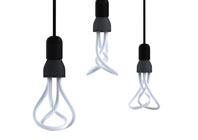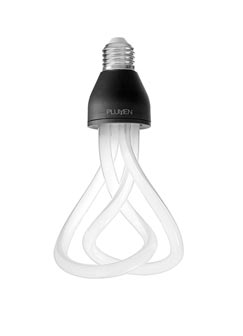Interview with Nicolas Roope, creator of the Plumen bulb
Hulger is a London-based boutique electronics brand established in 2005 by Michael-George Hemus and Nicolas Roope. The company has become famed for its unusual telephone designs for mobile phones, computers and iPads. The Plumen 001 is its first foray into light bulb design.
Launched in September 2010, Plumen is the antithesis of low energy light bulbs as we know them. Developed in collaboration with designer Sam Wilkinson, it has been built with beauty at its heart, glowing with the aesthetic of a sculptural object.
The Plumen bulb uses 80% less energy and lasts 8 times longer than incandescent bulbs, giving you the opportunity to purchase an ecological product with style. It works just like any low energy bulb but it has a lot more presence.
The product recently won the Brit Insurance Designs of the Year 2011, beating over 90 entries to claim the winning title.

The PLUMEN 001 works like any other high quality low energy bulb – saving you 80% on your energy bills and lasting 8 times longer than a standard incandescent bulb
D3D: How did the idea for the Plumen 001 come about?
Nicolas Roope: I can’t remember exactly. Was in 2006 some time. Just dropped into my head at some point, I can’t really remember. I don’t have ideas as big flashes but more small things that stew and stew and then finally bubble up and I say, “ah there’s one”
D3D: You collaborated with the designer Sam Wilkinson. What was your aim for the product and your brief to him?
Nicolas Roope: By the time we got Sam involved we had the manufacturer in place and a design concept that featured two mirrored organic forms as we have in the Plumen 001. The problem we had was it needed refining as a form and as it turned out we had to go through a series of more fundamental configuration changes to respond to production line issues that came up. We worked closely with Sam to navigate these issues and he really helped make sense of engineering demands and found a final form that really answered the ambitions of our earlier sketches.
D3D: Had you ever designed a low energy light bulb before? If not, did you have to carry out quite a bit of research into the materials and technology that would be suitable?
Nicolas Roope: We hadn’t designed one before. Without giving away too much I’d say we learnt the hard way. Trial and error working directly with the factory rather than the lab. The reason we took this approach is that most problems weren’t theoretical, they were practical. Things to do with processes on the production line that we needed to negotiate to flow our product through without disruption and therefore not adding lots of cost in labour and new tools. It worked.

The idea behind Plumen 001 was to make the bulb attractive and then people will spend a bit more and enjoy a better quality of light and a design they appreciate.
D3D: Where did the shape come from and how was it designed?
Nicolas Roope: We wanted the shape to be beautiful but not figurative or overly referential because then it all gets a bit too novelty. If it was an explicit shape of a flower for instance it would all start feeling a bit naff. But floral elements, the flowing decorative feathers of a bird, wisps of smoke, the ribbon shapes made by a gymnast were all inspiration. We merely suppressed any explicit reference. The mirroring of the two forms is very important because it gives the otherwise irregular shapes balance and symmetry. If an organic shape isn’t symmetrical then it naturally starts becoming directional, which doesn’t work if you’re a light bulb. Remember these products tend to be central in spaces and fittings and fixtures are built to surround them evenly. Introducing something directional starts to jar.
D3D: What materials were used in the design of the bulb?
Nicolas Roope: Pipe cleaners for sketching, rapid prototyping for refinement and an array of 3D packages for development.
D3D: The use of mercury is a problem in current bulbs because of its effects on the environment. Was the use of mercury in Plumen unavoidable?
Nicolas Roope: It is unavoidable but Plumen 001, like most modern CFLs [compact fluorescent lamp], only contain a fraction of the mercury that older ones contained. For a start, mercury is now added as a gas not a liquid and at much lower concentrations.
D3D: Would you say Plumen 001 is a sustainable product design? Perhaps not manufactured in the most sustainable way as, like many products, its manufactured in China but sustainable in the sense that it will last a long time?
Nicolas Roope: Yes absolutely. It lasts up to 8 times longer (8 fewer replacement products + manufacture + shipping + storage) than conventional bulbs and uses up to 80% less energy than the equivalent incandescent bulb. It does feel like a very large step in the right direction at the very least.
D3D: Do you think designers have a responsibility to bring sustainable products to market in order to change consumers’ behaviour?
Nicolas Roope: I think designers are the only people who can effectively do this. The problem is we mainly work for companies who don’t want to change the rules and so designers end up fuelling mindless consumption not challenging it. Designers can do it but they can’t do it on their own. It’s why Hulger is important in the equation because our will to use design to really change this is at the root of our product. We’re using design not just to seduce people to buy more stuff, we’re using it to help them reconsider the humble CFL and give them something to get excited about. Electric cars were spoddy until the Tesla showed us they could be sexy and in the flash of an eye electric cars are cool and desirable. I believe we’re doing the same for light bulbs.
Interview with Nicolas Roope, creator of the Plumen bulb
No






